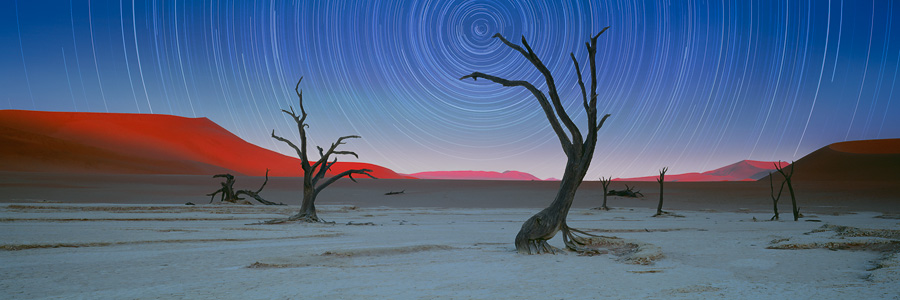P313H – Star Trail at Dead Vlei, Sossusvlei, Namibia, Africa
Here’s an interesting almost surreal photograph that I took years ago in the Namib Naukluft National Park in Namibia, Africa. This image is made up of two exposures, but unlike what many photographers do in the digital age today, both exposures in my case were performed on the same piece of film. This was taken before the concept of merging multiple images together or the term HDR ever existed. I had tried this concept a few times with success but you just don’t know how it will turn out until you see the developed film. I must say I was very happy.
I was given special permission from the director of the national park service to spend the night. This park is only open from one hour earlier than sunrise to one hour after sunset. There are very strict rules to follow here and the staff is amazing and knows if there is a missing car for the day and even who is in it. It was my plan to capture some late evening sunset images, perform a star trail at night and some early morning images. This area of the park (called Dead Vlei) is about 65 kilometers from the main gate, plus at least a 30 minute walk from the car park, so it’s really impossible to capture with the dramatic light around sunset and sunrise because either you have to leave too early to get to the main gate in time, or it’s too far to drive once they open it in the morning.
My initial plan was to capture a sunset with the star trail but I realized after the sun went down that I messed up my sunset exposure so I had to switch to a sunrise shot with the stars. It was a clear moonless night, and being in the middle of absolutely nowhere with no city for hundreds of miles, the sky was so dark that I could not see my hand in front of my face. The stars were brighter and more clear than anyplace I’d ever been. Once it became almost dark, I pointed my camera just south of the Southern Cross constellation, which is where the southernmost area of the sky is, and began my exposure. It felt so odd being out there, knowing that I was sharing this area with only a few wild animals and critters. No lion or anything in this part of the desert so I knew I was okay there, but still a bit spooky. After about 7 hours exposing the movement of the stars, I closed the shutter but did not move the camera or advance the film. I then needed to wait a couple hours until sunrise. I carefully installed a polarizer filter without moving the camera so I could keep the sky dark in my second exposure. I also purposely planned to underexpose the second shot about one and a half stops so I could keep the sky dark and so I wouldn’t overexpose the foreground from any residual light from the 7 hour exposure. The early morning light was quite spectacular. I used my second Linholf panoramic camera to photograph the early morning light around the area before it became time to return to my star trail camera where I carefully dialed in the polarizer and photographed the early morning light on the sand dunes as you see here. My second (morning) exposure was very quick, given my fairly wide open aperture setting. What you see is the combined photograph.


